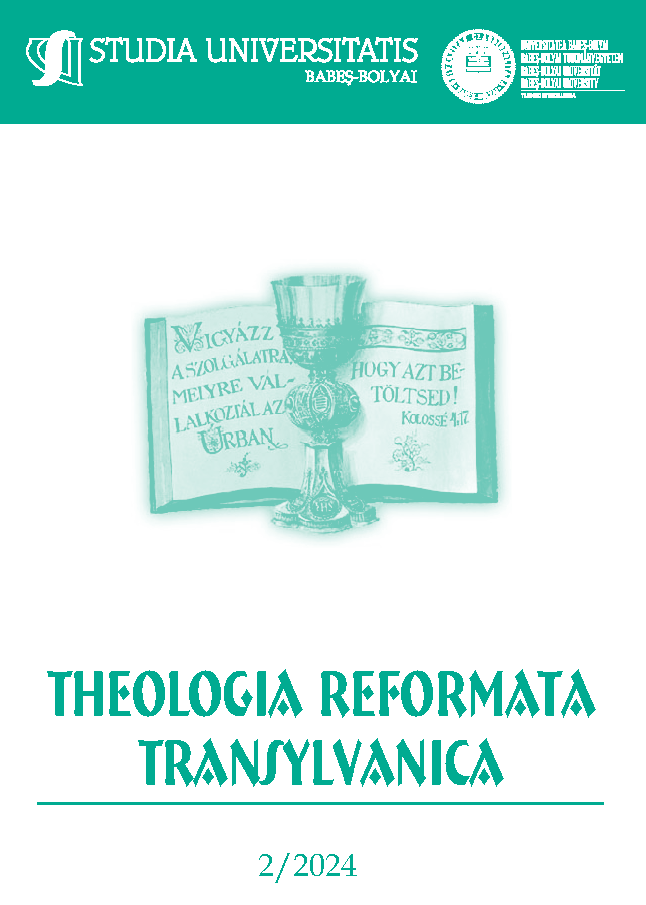Possibilities of Language Technology in Lexical Analyses of Canonical Hungarian Bible Translations
DOI:
https://doi.org/10.24193/subbtref.69.2.02Keywords:
Bible translations, language technology, statistics, theolinguisticsAbstract
The paper tries to attempt an unorthodox analysis of contemporary Hungarian Bible translations by using the software Sketch Engine. An important condition for computer-assisted linguistic analysis is a sufficient amount of textual data. In the case of Bible translations, “sufficient quantity” is easily attainable, since in this case a single translation represents the whole corpus. The corpus in this case is a properly annotated text: six Hungarian Bible translations. The paper highlights the fact that the computer-based text analysis can still reveal new features of Bible translations that are not found in the linguistic and hermeneutical analyses. In addition to the various layers of analysis of language use, it focuses on data like type-token characteristics, unigrams, bigrams, possible collocations, terms, orthographic error types, and orthographic variations of the chosen translations. Analyses show new correlations between translations or prove the well-known connections between translations, denominations, and sacred language use. Data and statistics can be used for several purposes – here, to gain more knowledge about Hungarian Bible translations. Statistics do not influence the work of the translators, and no far-reaching conclusions can be drawn from them. But they do provide a basis for a more detailed interpretation of a kind that is not possible during human reading.
References
Alkalmazott Nyelvtudomány [Hungarian Journal of Applied Linguistics] (2024): Teolingvisztikai különszám.
DE WAARD, Jan – NIDA, Eugene A. (1986): From One Language to Another: Functional Equivalence in Bible Translating. Nashville, Nelson.
DETWEILER, Robert (1985): What Is a Sacred Text? In: Semeia. 31, 213–230.
HANULA, Gergely (2016): Anyaszentnyelvünk. A „szent nyelvek” és a fordítás. Budapest, Argumentum Kiadó – ELTE BTK Vallástudományi Központ Liturgiatörténeti Kutatócsoport – Pápai Református Teológiai Akadémia.
JAKUBÍČEK, Miloš – KILGARRIFF, Adam – KOVÁŘ, Vojtěch – RYCHLÝ, Pavel – SUCHOMEL, Vít (2014): Finding Terms in Corpora for Many Languages with the Sketch Engine. In: Proceedings of the Demonstrations at the 14th Conference of the European Chapter of the Association for Computational Linguistics. Gothenburg, Association for Computational Linguistics. 53–56. https://doi.org/10.3115/v1/E14-2014.
KILGARRIFF, Adam – BAISA, Vít – BUŠTA, Jan – JAKUBÍČEK, Miloš – KOVÁŘ, Vojtěch – MICHELFEIT, Jan – RYCHLÝ, Pavel – SUCHOMEL, Vít (2014): The Sketch Engine: Ten Years On. In: Lexicography. 1, 7–36. https://doi.org/10.1007/s40607-014-0009-9.
KIRÁLY, Levente Zoltán (in press): Parallelizing Bible Texts. Developing the Database of the Unified Bible Reader online application. In: Argumentum.
KRAŠOVEC, Jože (2010): The Transformation of Biblical Proper Names. New York – London, T & T Clark.
KUSTÁR, Zoltán (2015): A bibliai héber nevek megjelenítése a nemzeti bibliafordításokban, különös tekintettel a legújabb protestáns bibliafordításainkra. In: Névtani Értesítő. 37, 25–32. https://doi.org/10.29178/NevtErt.2015.2.
M. PINTÉR, Tibor (2021): Online segédletek a magyar nyelvű bibliafordítások olvasásához. In: Modern Nyelvoktatás. 27, 3–4. 43–57. https://doi.org/10.51139/monye.2021.3-4.43.57.
(2022): Online bibliaolvasók szerepe és terminológiai megoldások keresése a bibliai konkordanciakészítésben. In: Alkalmazott Nyelvtudomány. 22, 1. 90–103.
M. PINTÉR, Tibor – P. MÁRKUS, Katalin (2021): Korpuszok a bibliafordításban mint a lexikológiai vizsgálatok eszközei. In: Fabiny, Tibor – M. Pintér, Tibor (eds.): πῶς ἀναγινώσκεις; Hogyan olvasod? Felekezeteket összekötő Egyesített Bibliaolvasó (EBO) felé. Budapest: Hermeneutikai Kutatóközpont. 72–89.
(2022): The Role of Online Bible Readers in Biblical Concordance Making. In: Hungarian Studies Yearbook. 4, 1. 183–196. https://doi.org/10.2478/hsy-2022-0009.
M. PINTÉR, Tibor – P. MÁRKUS, Katalin – BENŐ, Attila (2023): Termini Online Hungarian Dictionary and Database (TOHDD): A Dictionary for Hungarian Varieties Spoken in the Carpathian Basin. In: Acta Universitatis Sapientiae Philologica. 15, 2. 166–181. https://doi.org/10.2478/ausp-2023-0023.
NAUDÉ, Jacobus (2010): Religious Translation, In: Gambier, Yves – Van Doorslaer, Luc (eds.): Handbook of Translation Studies 1. Amsterdam, John Benjamins. 285–293. https://doi.org/10.1075/hts.1.rel3.
NORD, Christiane (2016): Function + Loyalty: Theology Meets Skopos. In: Open Theology. 2, 1. 566–580. https://doi.org/10.1515/opth-2016-0045.
P. MÁRKUS, Katalin – FAJT, Balázs – DRINGÓ-HORVÁTH, Ida (2023): Dictionary Skills in Teaching English and German as a Foreign Language in Hungary: A Questionnaire Study. In: International Journal of Lexicography. 36, 2. 173–194. https://doi.org/10.1093/ijl/ecad004.
WONDERLY, William L. (1970): Some Principles of “Common Language” Translation. In: The Bible Translator. 21, 3. 126–137. https://doi.org/10.1177/000608447002100303.
Bible Translations
KIF = Kecskeméthy (Csapó) István (1931/2002): Biblia [Bible]. Kolozsvár, CE Koinónia Kiadó.
KNV = (based on the rev. by György Káldi) (1997): Ó- és Újszövetségi Szentírás a Neovulgáta alapján [Káldi-Neovulgate]. Budapest, Szent Jeromos Katolikus Bibliatársulat.
RÚF = 2014: Biblia – Revideált új fordítású [Revised New Translation]. Budapest, Kálvin Kiadó – Magyar Bibliatársulat.
SZIT = Rózsa Huba (EIC) (1973): Biblia – Ószövetségi és Újszövetségi Szentírás [Bible of the Saint Stephen Association]. Budapest, Szent István Társulat.
ÚF = 1990: Biblia – Új protestáns fordítás. 1. revízió [New Translation]. Budapest, Kálvin Kiadó – Magyar Bibliatársulat.
ÚRK = 2020: Újonnan Revideált Károli-Biblia [Newly Revised Bible of Károli]. Budapest, Veritas Kiadó.
Downloads
Published
How to Cite
Issue
Section
License
Copyright (c) 2024 Studia Universitatis Babeș-Bolyai Theologia Reformata Transylvanica

This work is licensed under a Creative Commons Attribution-NonCommercial-NoDerivatives 4.0 International License.



